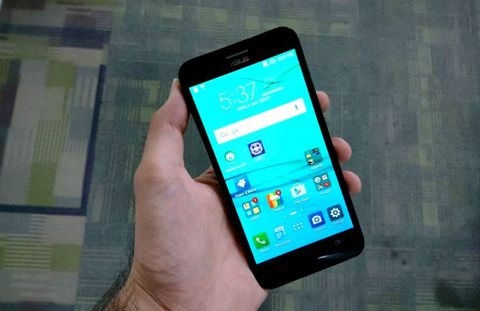TechRadar Verdict
The only good thing about the Asus ZenFone Max is its battery back-up. It fails to impress us in other aspects.
Pros
- +
Can last for more than a day
- +
Sturdy design
- +
Ample internal storage
Cons
- -
Low resolution display
- -
Average camera, Computing performance
Why you can trust TechRadar
Design 3/5
Features 3.5/5
Performance 3.5/5
Usability 4/5
Value 3.5/5
The competition in the sub-Rs 10,000 segment is increasing many folds. Consumers of today are also expecting their phones to double up as their laptops. But for a smartphone to function like that in a day, it needs to have a good battery back-up, and in this case Asus ZenFone Max takes the cherry on the cake.
A number of smartphone makers have tried to address the battery woes by tweaking around with the software part by offering stamina modes or by providing Quick Charge technology, but they still have not been able to crack the equation.
Asus too is looking at bridging the gap here by offering big battery affordable phones. The Taiwanese tech giant introduced ZenFone Max back in January, which was a sub Rs 10k smartphone and features a mammoth 5,000mAh battery unit. The phone managed to get decent traction and now Asus has given it a slight upgrade.
The revamped version of ZenFone Max was launched in May 2016 and it comes with a speedier processor, updated mobile OS, storage, etc.
But, will the refreshed Asus ZenFone Max still make the cut? Let's find out.
Specifications
Display : 5.5-inch HD 1280x720p display
OS : Android Marshmallow 6.0.1
CPU : 1.2 GHz octa-core Qualcomm Snapdragon 615 RAM: 2GB/3GB RAM
Storage : 32GB inbuilt memory, expandable by up to 64GB
Cameras : 13MP (rear), 5 MP (front)
Connectivity : Wi-Fi, 3G/4G/2G, GPS, Bluetooth, microUSB
Battery : 5,000mAh
Dimensions : 156 x 77.5 x 10.6 mm
Weight : 202 grams
Price : Rs 9,999 (2GB RAM), 12,999 (3GB RAM)

Design
Asus ZenFone Max is not much of a looker when it comes to design. Moreover, if you are in the market to buy a sleek and light weight handset, then you better explore other options as ZenFone Max is certainly not the kind.
This is because of its large 5,000mAh battery unit, which gives it a weight of 202 grams a noticeable width. However this should not create any trouble to consumers looking for a device, which can last longer than the regular smartphones. To me it's an acceptable trade off as I don't mind a slightly heavier smartphone if it gives enough juice to survive an entire day of heavy usage.
The smartphone is identical in terms of design to the original ZenFone Max, which was launched in January 2016. It follows the company's design philosophy the signature concentric circles at the front and a metallic strip running along the sides.

The front of the smartphone is occupied with a 5.5-inch 720p display with three touch capacitive buttons placed at the bottom. A 5MP camera is positioned at top along with earpiece and light sensor.
The removable rear panel has been given the same faux-leather touch (as seen on ZenFone Zoom) and sports a 13MP camera sensor along with dual-tone LED flash, laser module and the secondary noise cancellation mic. The audio is handled by a speaker unit placed at the bottom. The power button and the volume rockers are placed on the right side.
Overall, ZenFone Max feels quite sturdy and cannot be entitled as a cheap looking device, but then it brings nothing new to table.
Hardware
The latest ZenFone Max gets a significant upgrade in the form of underlying processor. The smartphone upgrades on previous variant by packing in speedy octa-core Snapdragon 615 processor as compared to the Snapdragon 410 that powered up the original ZenFone Max.
In this version of ZenFone Max, users have an option to pair up the processor with either 2GB RAM or 3GB RAM. Both the variants gets 32GB inbuilt memory, which can be expanded by up to 64GB via microSD card.
As far as connectivity goes, ZenFone Max has 4G LTE, 3G, GRPS/EDGE, GPS, Bluetooth 4.0 and Wi-Fi.
Display
The new ZenFone Max has not improved on display resolution in comparison to its predecessor. It is shipped with the same 5.5-inch 720p display, which is only good for basic multimedia tasks whereas the other similarly priced phones like Xiaomi Redmi Note 3, Lenovo K3 Note, Yu Yureka Plus, have an edge over it, thanks to their 1080p screens. The HD display of ZenFone Max does not offer the same kind of sharpness and colour reproduction that either of these smartphones provide.

The lower resolution display helps the ZenFone Max last longer in terms of battery performance but it can be a real deal breaker for some users. Having said that, the content does not look crisp and the viewing angles are also not up to the mark. Besides, the display has an overall warmer tone to it and its brightness levels does not match the likes of Xiaomi Redmi Note 3, LeEco Le 1S, etc.
To compensate, Asus has added a number of software tweaks that will help you customize the display as per your requirement. The display settings come with a Splendid app, which offers a Balance mode, a Bluelight Filter, Vivid, and a custom setting mode where you can set the Hue and saturation as per your liking.
Performance: A battery monster
The highlight of the smartphone is definitely its 5,000mAh battery unit, which also serves as a power bank. It is worth mentioning that the ZenFone Max is all about battery power and it manages to please with the one feature it is designed for.
I managed to get a two days backup with a heavy usage on ZenFone Max and during this time I also used the device to charge another smartphone. If you are a moderate user, you can easily extract a battery backup of more than two days from the smartphone.
Besides, the Snapdragon 615 SoC left us a bit confused. At times it managed to offer a decent overall performance, but then there were instances when the smartphone struggled to execute even basic tasks such as loading up the dialer or the notes app. We had got the 2GB RAM variant for the review and the multitasking experience was not pleasing. As mentioned earlier there is another variant available that offers 3GB of RAM, and is priced at Rs 12,999.

The sluggish performance is also due to the heavily customized Asus ZenUI, which comes pre-loaded with unnecessary Asus bloat wares. Sadly, you cannot uninstall them.
Besides processor, the new ZenFone Max upgrades on internal storage. There is 32GB inbuilt memory, which can be expanded to 64GB via microSD card. The original ZenFone Max has only 16GB internal storage.
Camera
There's nothing much to talk about the camera as the smartphone ships with the same 13MP rear and a 5MP front camera. You get the Asus' PixelMaster technology and a plenty of interesting modes to play with such as Low light mode, manual mode, miniature photography, super resolution, etc. A total of 14 modes are provided, which will be enough to keep you busy as you fire up the snapper.

The front and rear camera are only good for basic imaging and fails to match the camera performance of Xiaomi Redmi Note 3, Le Eco Le 1S, etc.
Likes
The only saviour here is the good battery backup and ample internal storage.
Dislikes
The Asus ZenFone Max is marred by a low resolution display, boring design and mediocre camera performance. Computing and multitasking performance are also not the best in the competition.
Verdict
To call Asus ZenFone Max a perfect upgrade will not be fair. You may be able to save on battery with the smartphone but it brings nothing concrete in other performance areas.
Buy it if you are looking for a smartphone that can last longer and offer basic performance in camera, display and multitasking.
Rohit Arora is the Senior Correspondent at Gizbot, OneIndia. He has been exploring technology since early 90s and started working with Print media in 2014. After writing for PC Quest, Voice & Data and Data Quest for over 14 months, I joined TechRadar in 2016 (Noida). Rohit provides strategic ideas to leading tech brands for new product launches and marketing campaigns.


